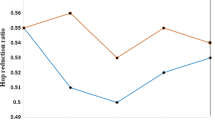Abstract
Content-centric network (CCN) is a new Internet architecture in which content is treated as the primitive of communication. In CCN, routers are equipped with content stores at the content level, which act as caches for frequently requested content. Based on this design, the Internet is available to provide content distribution services without any application-layer support. In addition, as caches are integrated into routers, the overall performance of CCN will be deeply affected by the caching efficiency.
In this paper, our aim is to gain some insights on how caches should be designed to maintain a high performance in a cost-efficient way. We try to model the two-layer cache hierarchy composed of CCN routers using a two-dimensional discrete-time Markov chain, and develop an efficient algorithm to calculate the hit ratios of these caches. Simulations validate the accuracy of our modeling method, and convey some meaningful information which can help us better understand the caching mechanism of CCN.
Similar content being viewed by others
Explore related subjects
Discover the latest articles and news from researchers in related subjects, suggested using machine learning.References
Jacobson V, Smetters D K, Thornton J D, Plass M F, Briggs N H, Braynard R L. Networking named content. In: Proceedings of the 5th ACM International Conference on Emerging Networking Experiments and Technologies. 2009, 1–12
Che H, Tung Y, Wang Z. Hierarchical web caching systems: modeling, design and experimental results. IEEE Journal on Selected Areas in Communications, 2002, 20(7): 1305–1314
Rosensweig E J, Kurose J, Towsley D. Approximate models for general cache networks. In: Proceedings of IEEE International Conference on INFOCOM. 2010, 1–9
Trivedi K S. Probability and Statistics with Reliability, Queuing, and Computer Science Applications. 2nd ed. New York: John Wiley & Sons, 2001
Busari M, Williamson C. ProWGen: A synthetic workload generation tool for simulation evaluation of web proxy caches. Computer Networks, 2002, 38(6): 779–794
Saleh O, Hefeeda M. Modeling and caching of peer-to-peer traffic. In: Proceedings of the 14th IEEE International Conference on Network Protocols. 2006, 249–258
Williamson C. On filter effects in web caching hierarchies. ACM Transactions on Internet Technology, 2002, 2(1): 47–77
Jacobson V, Smetters D K, Briggs N H, Plass M F, Stewart P, Thornton J D, Braynard R L. VoCCN: voice-over content-centric networks. In: Proceedings of the Workshop on Re-architecting the Internet. 2009, 1–6
Kumar S, Shi L, Ahmed N, Gil S, Katabi D, Rus D. Carspeak: a content-centric network for autonomous driving. ACM SIGCOMM Computer Communication Review. 2012, 42(4): 259–270
Oh S Y, Lau D, Gerla M. Content centric networking in tactical and emergency MANETs. In: Proceedings of IEEE International Federation for Information Processing Wireless Days. 2010, 1–5
Meisel M, Pappas V, Zhang L. Ad hoc networking via named data. In: Proceedings of the 5th ACM International Workshop on Mobility in the Evolving Internet Architecture. 2010, 3–8
Wong W, Nikander P. Secure naming in information-centric networks. In: Proceedings of the Re-Architecting the Internet Workshop. 2010, 1–6
Arianfar S, Nikander P, Ott J. On content-centric router design and implications. In: Proceedings of the Re-Architecting the Internet Workshop. 2010, 5
Tarkoma S, Kuptsov D, Savolainen P, Sarolahti P. CAT: a last mile protocol for content-centric networks. In: Proceedings of IEEE International Conference on Communications Workshops. 2011, 1–5
Dan A, Towsley D. An approximate analysis of the LRU and FIFO buffer replacement schemes. ACM SIGMETRICS Performance Evaluation Review, 1990, 18(1): 143–152
Carofiglio G, Gehlen V, Perino D. Experimental evaluation of memory management in content-centric networking. In: Proceedings of IEEE International Conference on Communications. 2011, 1–6
Rossi D, Rossini G. Caching performance of content centric networks under multi-path routing. Relatório téconico, Telecom ParisTech, 2011
Rossi D, Rossini G. On sizing CCN content stores by exploiting topological information. In: Proceedings of INFCOM Workshops. 2012, 280–285
Fricker C, Robert P, Roberts J, Sbihi N. Impact of traffic mix on caching performance in a content-centric network. In: Proceedings of IEEE Conference on Computer Communications Workshops. 2012, 310–315
Psaras I, Clegg R G, Landa R, Chai W K, Pavlou G. Modelling and evaluation of CCN-caching trees. In: Proceedings of the 10th International IFIP TC 6 Conference on Networking. 2011, 78–91
Carofiglio G, Gallo M, Muscariello L, Perino D. Modeling data transfer in content-centric networking. In: Proceedings of the 23rd International Teletraffic Congress. 2011, 111–118
Jia Z, Zhang P, Huang J, Lin C, Lui J C S.Modeling hierarchical caches in content-centric networks. In: Proceedings of the 22nd International Conference on Computer Communications and Networks. 2013, 1–7
Author information
Authors and Affiliations
Corresponding author
Additional information
Zixiao Jia received his ME from Institute of Computing Technology, Chinese Academy of Sciences, China in 2010, and obtained his PhD in the Department of Computer Science and Technology at Tsinghua University, China. He is currently an engineer of the National Computer Network Emergency Response Technical Team/Coordination Center of China, China. His research interests include performance evaluation and next generation Internet.
Jiwei Huang received his BE and PhD in computer science and technology from Tsinghua University, China in 2009 and 2014, respectively. He is an assistant professor in the State Key Laboratory of Networking and Switching Technology at Beijing University of Posts and Telecommunications, China. He was a visiting scholar at Georgia Institute of Technology, USA. His research interests include services computing and performance evaluation.
Chuang Lin received his PhD degree in computer science from Tsinghua University, China in 1994. He is now a professor of the Department of Computer Science and Technology, Tsinghua University, China, and he is also an honorary visiting professor of University of Bradford, UK. His research interests include computer networks, performance evaluation, network security analysis, and Petri net theory and its applications.
Rights and permissions
About this article
Cite this article
Jia, Z., Huang, J. & Lin, C. Hierarchical caches in content-centric networks: modeling and analysis. Front. Comput. Sci. 9, 846–859 (2015). https://doi.org/10.1007/s11704-015-4064-7
Received:
Accepted:
Published:
Issue Date:
DOI: https://doi.org/10.1007/s11704-015-4064-7




